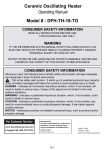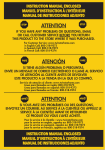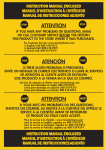Download Speco Technologies VMS-2 User's Manual
Transcript
VMS-2 4” Color LCD Service Monitor Kits User’s Manual Copyright @1998 by this company. No Part of this publication may be reproduced, transmitted, transcribed, stored in a retrieval system or translated into any language or computer language, in any form or any means. Electronic, mechanical, magnetic, optical, chemical, manual or otherwise, without the prior written permission of this company. I. Security notes The unit is only suitable for indoor use. The heat being generated in the unit has to be removed via air circulation. Therefore the circulation vents in the housings must not be covered with any objects. Do not insert or drop anything into the air vents ! This could result in a short-circuit. If the unit is used for purposes other than originally intended, if it is connected in the wrong way or not repaired by authorized skilled personnel, there is no liability for possible damage. Do not use any fluid, cleaning chemicals or abrasive materials. If the unit is to be scraped then take it to the local recycling plant for disposal. We do not accept any liability for the following : a) If the unit is used for purposes other than originally intended. b) If The unit is wrongly connected. c) If the unit is not repaired by an qualified authorized engineer. II. Application range The LCD color monitors LSM-413 active matrix technology offer a sharp and high contrast display. It can be universally used for Surveillance systems, In-Vehicle Reverse monitoring systems or for Multimedia applications. The additional Audio input enable sound reception via Headphones. I. CONTENTS : 1. 4” LCD monitor 2. Carry Bag and Belts 3. 1000mA Rechargeable Ni-H Battery 4. Three velcos , two for monitor and one for battery. 5. 30 cm power cord. 6. 15V DC Charger. This Charger should only be used to charge the battery NOT to supply the unit. If used on the unit Serious damage may occur which will not be covered by the warranty. 7. RCA to BNC adapter 4 pcs. 8. Spacer Protector II . Power Operating and Connections 1. Please charge the Ni-H Battery for one and half hours before using it for the first time. 2. Please stick two velcos to the rear of monitor. Then place the monitor in the correct position in the bag. This will then fasten the monitor to the bag will restrict any movement when the bag lid is open. 3. Connect the battery to monitor via the DC power cord (Supplied). III. LCD Monitor Operation and Connections : Controls and Connectors on LCD monitor: 1. Brightness control 2. Contrast Control 3. Volume control for headphones 4. Audio output for headphones 5. Main Power switch 6. Video Left-Right Reverse Switch 7. Audio input 8. Video output 9. Video 1Input 10. Video 2 Input 11. Video Input 1or 2 Switch 12. 12V DC Power Input 1) Switch on the monitor using the Main Power switch (5). 2) Adjust the brightness control (1) and Contrast (2) in order to obtain an image as clear and sharp as possible. 3) Adjust the volume control of the headphones iii.. Connections 1) Connect the video source to the Video input 1(9) or Video 2(10) Inputs. 2) Select the correct Video input using the Video Input switch (11). 3) Connect the Audio source to the audio input (7). 4) Connect an electronically regulated 12V power supply The positive pole must be connected to the center contact. 5) Connect headphones to the Audio Output if required. i Operation 1) Switch on the monitor using the Main Power switch (5). 2) Adjust the brightness control (1) and Contrast (2) in order to obtain an image as clear and sharp as possible. 3) Adjust the volume control of the headphones to the desired level. 4) Select the correct Video Input. vi. Technical Data LCD technology: TFT active matrix Display size: 4” Active area : 82.1 x 61.8 mm Color system: NTSC or PAL Sync. :.Horizontal :15, 625 Hz, Vertical : 50 Hz. Resolution: 480 x 234 , 112,320 Pixels Audio level: 1V/10k Video Input : 1Vpp 75 £[ Dimensions ( Bag ) :190.0 (W) x 130.0 (H) x 60 (D) mm Weight : 1.2 Kg CAUTION: When using headphones do not adjust the volume to a high position. Start at the lowest setting and gradually raise it so it can be heard. The human ear gets accustom to the volume setting, so do not further increase the volume after getting used to it. Permanent high volumes can seriously damage your hearing.









